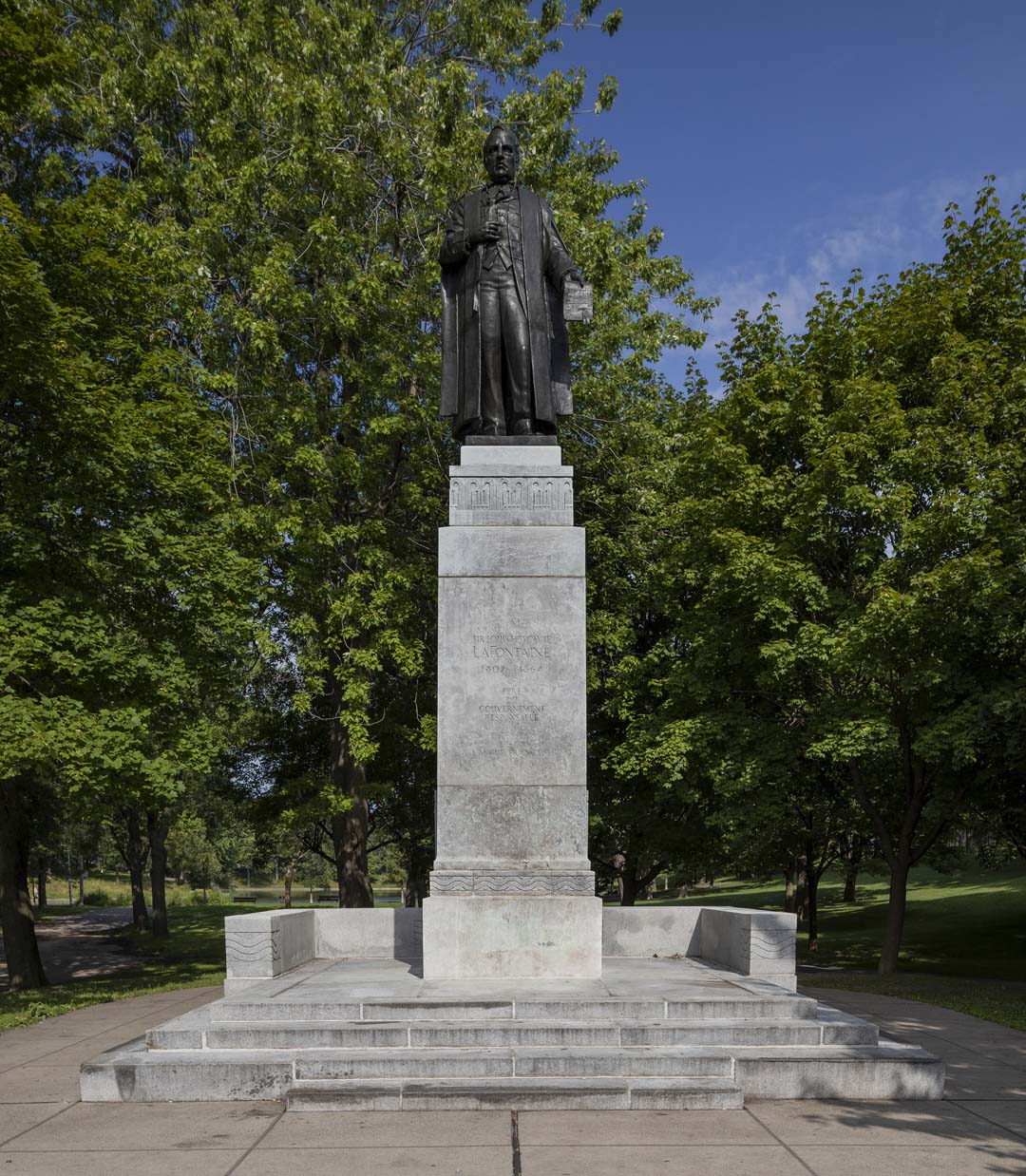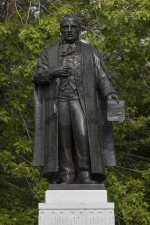Henri Hébert
Monument à sir Louis-Hippolyte La Fontaine
1930
Presentation of the artwork
This architectural and sculptural ensemble, situated in the southwest corner of Parc La Fontaine, offers a portrayal of the political figure Sir Louis-Hippolyte La Fontaine. The bronze statue in his likeness is wearing the robe of a justice of the Court of Queen’s Bench, the court that he created and the position he occupied for the last 10 years of his life. La Fontaine holds in his left hand a document on which are engraved the words “gouvernement responsible” (responsible government), the phrase that summarized his political life. This statue is inspired by another work portraying La Fontaine that the sculptor, Henri Hébert, executed in 1921 for the façade of the National Assembly building in Québec City.The pedestal is very plain: its play of lines and volumes and its stylized decorative elements are inspired by Art Deco. The bas-reliefs, “La Liberté,” “Le Courage,” and “La Législation,” on the pedestal symbolically illustrate aspects of La Fontaine’s personality and achievements.
Associated events
Louis-Hippolyte La Fontaine, a jurist and politician, was born in Boucherville in 1807. He began his political career as a member of the Assembly of Lower Canada for Terrebonne; from 1834 to 1836, he represented the Saint-Joseph neighbourhood on the Montréal Municipal Council. His name is associated with the 1837 rebellion, and he was imprisoned in 1838. The premier of Lower Canada in 1842–43 and again from 1848 to 1851, he is considered the father of parliamentary democracy (responsible government). In 1851, he returned to practising law and was appointed chief justice of the Court of Queen’s Bench. He died in Montreal at age 57.
Henri Hébert
The son of the sculptor Louis-Philippe Hébert, Henri Hébert was born in Montréal in 1884. He was trained at the École des beaux-arts and the École des arts décoratifs in Paris, then returned to Montréal in 1909. His career was divided between executing various commissions and teaching. In 1910, he became a member of the faculty of the School of Architecture at McGill University, and in 1923, he taught modelling at the Conseil des arts et manufactures at the Monument national. In 1940, Hébert received an honorary doctorate from the Université de Montréal. An associate member of the Royal Canadian Academy of Arts, he died in Montréal at the age of 66.
Awards and honours
- doctorat honorifique par l’Université de Montréal, 1940
- Membre associé de l’Académie royale des arts du Canada,
Presentation of the artwork
This architectural and sculptural ensemble, situated in the southwest corner of Parc La Fontaine, offers a portrayal of the political figure Sir Louis-Hippolyte La Fontaine. The bronze statue in his likeness is wearing the robe of a justice of the Court of Queen’s Bench, the court that he created and the position he occupied for the last 10 years of his life. La Fontaine holds in his left hand a document on which are engraved the words “gouvernement responsible” (responsible government), the phrase that summarized his political life. This statue is inspired by another work portraying La Fontaine that the sculptor, Henri Hébert, executed in 1921 for the façade of the National Assembly building in Québec City.The pedestal is very plain: its play of lines and volumes and its stylized decorative elements are inspired by Art Deco. The bas-reliefs, “La Liberté,” “Le Courage,” and “La Législation,” on the pedestal symbolically illustrate aspects of La Fontaine’s personality and achievements.
Associated events
Louis-Hippolyte La Fontaine, a jurist and politician, was born in Boucherville in 1807. He began his political career as a member of the Assembly of Lower Canada for Terrebonne; from 1834 to 1836, he represented the Saint-Joseph neighbourhood on the Montréal Municipal Council. His name is associated with the 1837 rebellion, and he was imprisoned in 1838. The premier of Lower Canada in 1842–43 and again from 1848 to 1851, he is considered the father of parliamentary democracy (responsible government). In 1851, he returned to practising law and was appointed chief justice of the Court of Queen’s Bench. He died in Montreal at age 57.
Henri Hébert
The son of the sculptor Louis-Philippe Hébert, Henri Hébert was born in Montréal in 1884. He was trained at the École des beaux-arts and the École des arts décoratifs in Paris, then returned to Montréal in 1909. His career was divided between executing various commissions and teaching. In 1910, he became a member of the faculty of the School of Architecture at McGill University, and in 1923, he taught modelling at the Conseil des arts et manufactures at the Monument national. In 1940, Hébert received an honorary doctorate from the Université de Montréal. An associate member of the Royal Canadian Academy of Arts, he died in Montréal at the age of 66.
Awards and honours
- doctorat honorifique par l’Université de Montréal, 1940
- Membre associé de l’Académie royale des arts du Canada,






